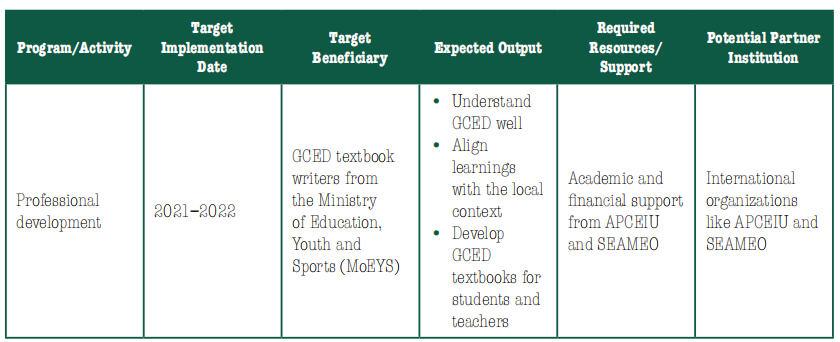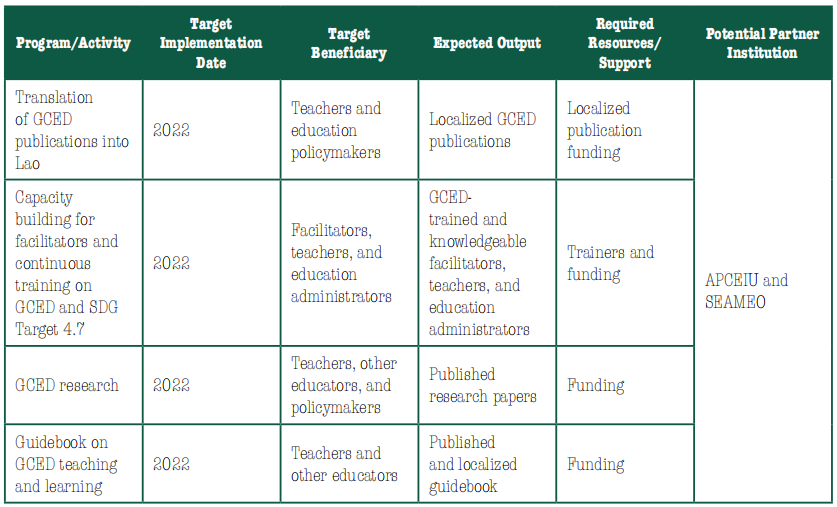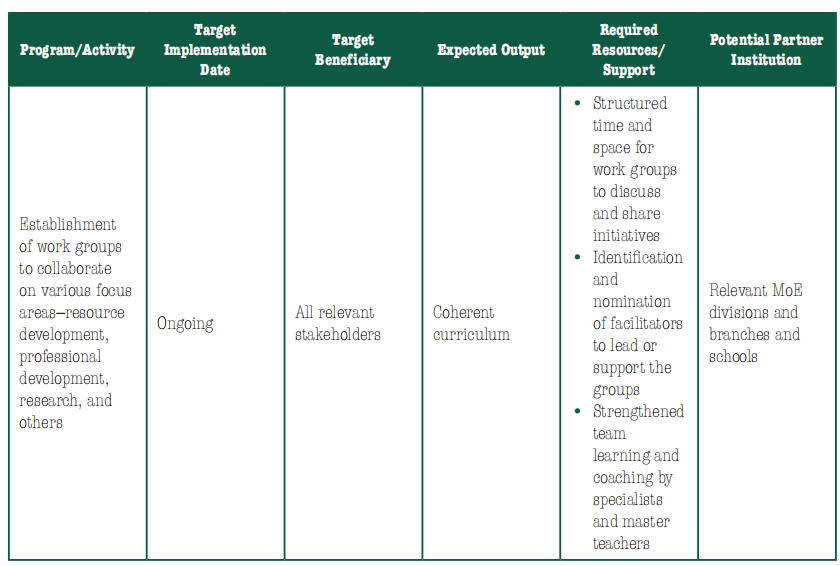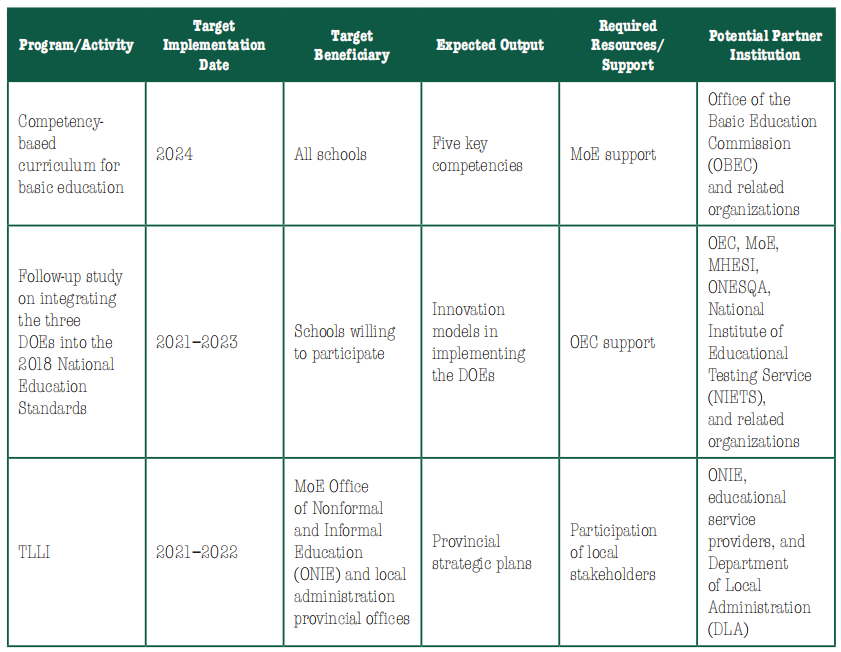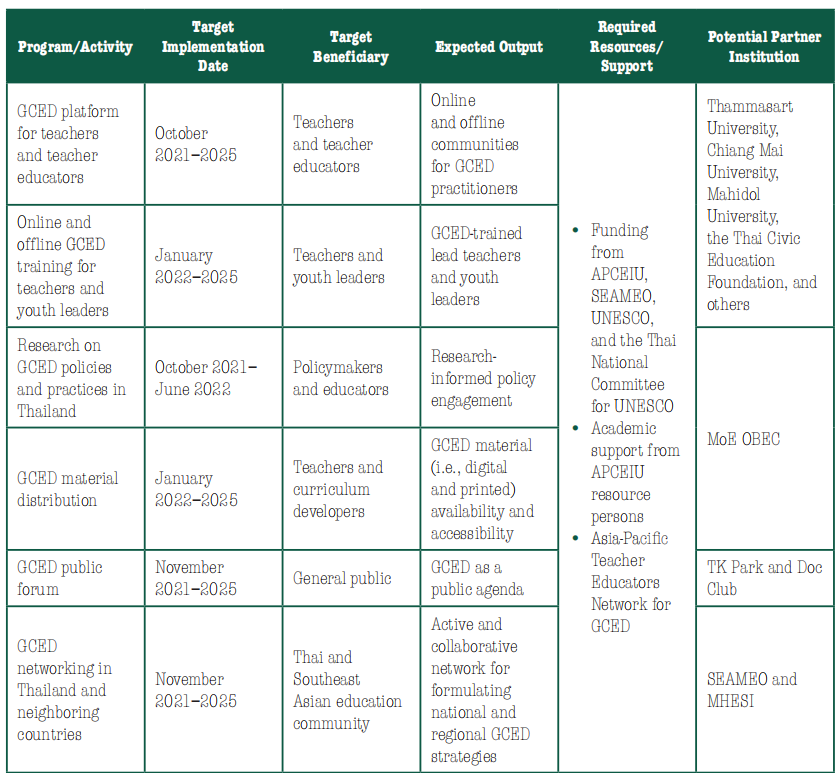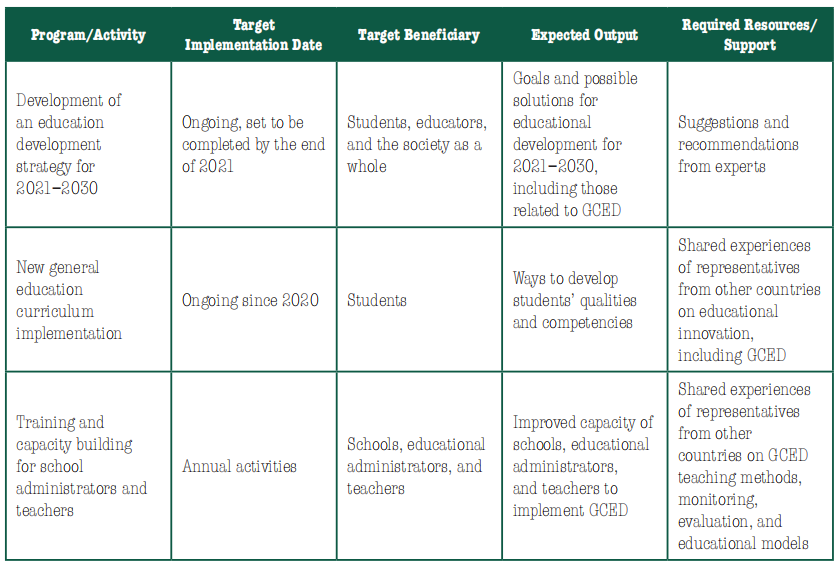Current status of gced implementation in southeast asia
The following status of Global Citizenship Education implementation in some of Southeast Asian countries were taken from the report of the representatives of SEAMEO Member Countries that were invited to discuss their GCED implementations and action plans to hasten the realization of SDG Target 4.7 aligning with SEAMEO Priority Areas. The status were shared during the Virtual Consultation Meeting on Global Citizenship Education hosted by SEAMEO Secretariat and APCEIU that conducted on 21 of August 2021.
Ms. Hajah Rosinah binti Haji Sabli from MoE Brunei Darussalam and Ms.Hajah Siti Aminah binti Haji Jumaat from the Brunei Darussalam Leadership and Teacher Academy shared about their country’s GCED implementation progress since the “Subregional Workshop on GCED in Southeast Asia” co-organized by APCEIU and SEAMEO back in 2019.
Ms. Jumaat said the country’s existing social studies curriculum has three domains—pure history (30%), pure geography (30%), and other social aspects (40%). Following the 2019 workshop, both speakers shared that they proposed that the government change its social studies curriculum to include GCED and change the proportions to pure history (40%), pure geography (40%), and GCED (20%).
Ms. Jumaat said the country’s existing social studies curriculum has three domains—pure history (30%), pure geography (30%), and other social aspects (40%). Following the 2019 workshop, both speakers shared that they proposed that the government change its social studies curriculum to include GCED and change the proportions to pure history (40%), pure geography (40%), and GCED (20%).
Moreover, in 2019, Brunei Darussalam analyzed the status of its social studies curriculum for Years 7 and 8. Ms. Jumaat added that social studies is only taught in Years 7 and 8. Students in Years 9 and 10 can choose to take geography or history.
This year, Brunei Darussalam plans to integrate GCED as a sub theme in its social studies curriculum for Years 7 and 8 in one pilot school. At present, the committee in charge of the integration completed 70% of the syllabus. It plans to publish a complementary book to assist teachers in implementing the new social studies curriculum.
Dr. Mok Sarom said Cambodia has been working with SEAMEO
since 2016 to integrate GCED into its national curriculum. The country reformed
its national curriculum by injecting elements of GCED, particularly in history
and moral civics for Grades 1–12 students. At present, Cambodia is also
participating in APCEIU’s International Teacher Exchange Project to promote
awareness of the importance and understanding of GCED among its teachers.
Ms. Farah Arriani from the Ministry of Education, Culture, Research and Technology (MoECRT) began by sharing a background of education in Indonesia. Indonesia believes that education has an important role in influencing social change. Despite the country’s diversity in terms of ethnicity and culture, it strives to ensure unity through the Pancasila—the five philosophies of national life—and ensuring the availability of a curriculum that suits its citizens’ needs.
GCED is recognized as an important element in preparing students to become active contributors to a more peaceful, tolerant, inclusive, and secure world. As such, it is being integrated into the Indonesian curriculum as far back as 1947, as part of character education and state and community awareness.
Ms. Arriani continued by saying that the values and morals espoused in the Pancasila, which coincide with GCED, have been included in the country’s curriculum. As such, it develops in students the attitudes, knowledge, and skills that place the Indonesian culture at the heart of education. In particular, the curriculum aims to make all Indonesians:
- Religious and respectful of other religions
- Love their nation, homeland, and country
- Concerned about developing just national, social, and economic lives
- Ensure democracy that respects social and cultural pluralism
- Contributors to realizing dignified and respected human lives
- Contributors to building a socially just society
The values and morals in the Pancasila are not taught exclusively through various subjects. Instead, the government is using a whole-school approach that teaches them throughout the learning ecosystem and through cultural, co-curricular, and extra-curricular activities. It also elicits the help of families and the entire society.
GCED is being integrated into school subjects, such as Pancasila education and citizenship and religion. It is also integrated into educational content to equip students not just with the knowledge but also skills and attitudes they need to recognize and love the natural, social, cultural, and spiritual areas of their environment and understand the nation’s diversity. GCED is also integrated into extra-curricular activities, such as scouting, hiking, and collaborative social projects.
GCED is also connected to national character building, as the nation’s education policy highlights diversity. As such, students need to develop 18 values—tolerance, social care, caring for the environment, responsibility, and peace. They need to become good-minded, good-hearted, and well-behaved individuals.
Ms. Arriani continued by presenting Indonesia’s education vision—to realize a developed Indonesia that is sovereign, independent, and has personality through the creation of Pancasila-trained students. To do that, Pancasila education is taught from early childhood to secondary level, even in special schools. The subject aims to teach children to:
- Have faith, fear of God, and nobility
- Become independent
- Be capable of critical reasoning
- Have respect for global diversity
- Be collaborative
- Be creative
To ensure that the students understand what they are taught, context is applied to all content and experience-based learning is used. In particular, their learning focuses on five themes that are related to the SDGs and the Pancasila—diversity, climate change, bullying, entrepreneurship, and technology and engineering. Lessons are extended to intra- and extra-curricular activities and the school culture. When they graduate, they will be equipped with 21st-century skills and understand various culture and values and respect differences among people.
Dr. Silinthone Sacklokham from the Ministry of Education and Sports (MoES) of Lao PDR shared that since 2019, the country has been implementing GCED capacity-building programs, disseminating related information, and participating in connected meetings and conferences. The country has started implementing GCED capacity-building programs at the national and international levels.
Ms. Noor Hayati binti Uteh from MoE Malaysia began by reiterating the importance of transformative GCED. To ensure that it is, we need to ensure that teaching and learning provide students opportunities to participate actively in addressing and making connections among global and national issues, such as social, political, economic, or environmental challenges. Another critical issue is integrating core GCED conceptual frameworks and dimensions (i.e., cognitive, socio-emotional, and behavioral) into general education.
- Align the lower secondary curriculum in math, science, history, and geography with the SDGs and create GCED project-based lessons
- Develop lesson plans and teaching materials for the identified projects
- Test the lessons developed among students in a classroom environment and gather feedback from them, teachers, and MoE curriculum officers on how effective they are
- Train teachers from selected pilot schools to run the project in their respective subjects
The phase is expected to produce these results:
- A total of 20 lessons for Form 1 that are aligned with more than 10 SDGs
- Mock lessons to evaluate the project conducted in two pilot schools among 186 students; 90% of the students should become interested in learning more about global issues afterward
- Centralized training for teachers from four pilot schools on implementing GCED PBL in classrooms
Ms. Uteh continued by showing how SDG 3 and GCED objectives have been integrated into the country’s geography syllabus for Grade 7. That should encourage students to learn more about tracing COVID-19 cases across Malaysia.
Phase 2 of the project aims to:
- Run the monitoring and evaluation processes for all students involved in the pilot to gather data on the effectiveness of PBL in developing responsible global citizens
- Provide customized in-school support and assistance to schoolteachers so they can plan for and implement their PBL teaching strategies in the classroom
- Develop a professional learning community (PLC) that encourages collaboration among teachers to develop GCED PBL lessons aided by continuous professional development
To design the project, MoE used UNESCO Bangkok’s PBL design called “CREATE,” which espouses the following:
- Mapping out a curriculum-based and contextualized theme
- Choosing real-world issues to ensure that topics are authentic and relevant to the Students
- Using expert thinking to improve students’ higher-order thinking skills (HOTS) to investigate and solve problems and make sure they are open-ended (i.e., there are no wrong or right solutions)
- Ensuring that learning results are achievable and measurable
- Fostering teamwork
- Ensuring that learning times, space, and impact extend beyond classroom
- boundaries
Ms. Uteh said that PBL is usually conducted at the end of a process. In MoE’s case, however, PBL was started from the beginning.
Before concluding her presentation, she introduced the Digital Education Learning Initiative Malaysia (DELIMa) Platform all teachers can use. It was the product of a project funded by the United Nations International Children’s Emergency Fund (UNICEF) in Malaysia. This platform gives teachers and students information about PBL use in the classroom. It guides teachers on employing the strategy while aligning lessons with the SDGs and GCED-related objectives. She said that COVID-19 increased the demand for sophisticated learning tools, such as DELIMa. Challenges remain, however, such as how to connect the dots between what students learn in class and the actual issues they face in real life. As such, she believes teachers need more support.
Dr. Margarita Consolacion Ballesteros represented the Department of Education (DepEd) of the Philippines to present the current status of GCED implementation in the country. She said that the Philippines became a member of the Group of Friends for Solidarity and Inclusion with GCED on 26 May 2021.
The group started of with 11 member countries—Armenia, Austria, Bangladesh, Colombia, Italy, Jordan, Kenya, the Philippines, the Republic of Korea, Senegal, and Serbia. In a joint statement, they reaffirmed that closer global cooperation is crucial to eradicating COVID-19.
The Philippines also took part in the GCED Curriculum Development and Integration Project. On 2 June 2020, the Philippine Normal University (PNU), which is considered the country’s National Center for Teacher Education, was designated by the DepEd as the project’s implementing partner. PNU has been working closely with APCEIU and DepEd for the second and third phases of the project, which aims to strengthen the full integration of GCED into DepEd’s curriculum standards.
In November 2020, the second phase
of the GCED Curriculum Development and Integration Project was successfully
completed by PNU. It had four objectives, namely:
- Develop a list of Philippine GCED indicators
- Map Philippine GCED indicators to the contents of the basic education curriculum
- Develop the Philippine GCED Framework
- Elaborate how the GCED Framework can be integrated into the K–12 curricula by identifying the knowledge, skills, and attitudes related to the concept
These objectives produced relevant documents and outputs that were implemented in phase 3. This phase is still ongoing and has four objectives and six expected outputs shown in the following table.
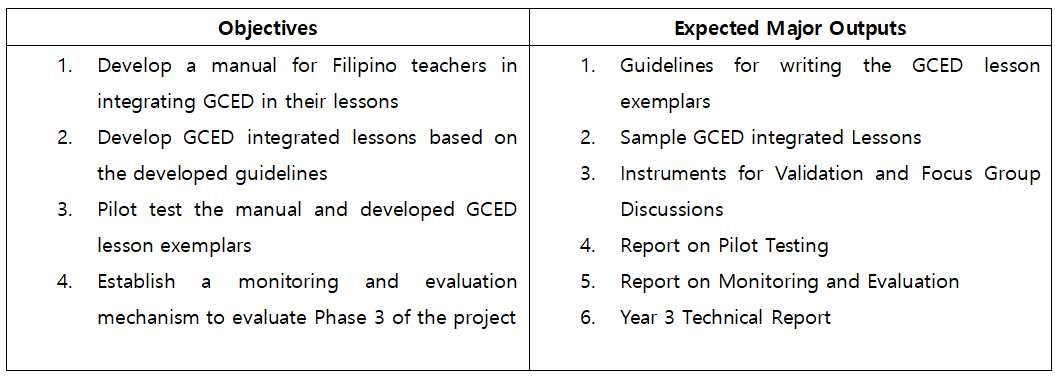
Dr. Ballesteros explained that the Philippines also takes part in the Korea-Philippines Teacher Exchange Programme (KPTEP) organized by APCEIU. The Philippines and APCEIU started KPTEP back in 2012. It aims to provide Korean and Filipino teachers constructive experiences to:
- Learn from each other’s education system
- Deepen their cultural understanding
- Build inter-cultural communicative competency in teaching while collaborating with local teachers
- Strengthen the existing education network between the two countries
The country’s social studies curriculum promotes global citizenship. As the students get older, they learn more about the concept. The curriculum aims to help students become informed, concerned, and participative citizens.
Singapore utilizes the humanities inquiry approach to implement the curriculum and promote GCED. To ensure its effectiveness, it is important to sustain a culture of inquiry in classrooms. The key features of the Social Studies Primary (SSP) 2020Curriculum, which enhances the development of global citizenship competencies, are:
- Instructional materials that emphasize strong foundational humanities knowledge and skills
- Learning experiences that help students develop citizenship competencies
- Learning experiences that nurture students’ understanding of Southeast Asia and the world
- Stories and digital and tactile resources that enhance student learning
- Professional development for teachers so they can teach global citizenship competencies
Ms. Sim continued by saying that instructional materials provide students with strong foundational knowledge and skills in humanities. They let students acquire content knowledge and disciplinary skills, such as historical and geographical inquiry, critical thinking, perspective taking, information, and digital literacy skills. Ms. Sim also introduced SURE, an online platform jointly developed by MoE and the National Library Board ,to teach students to determine there liability of digital sources. MoE also prepared a step-by-step guide for teachers to imbue students with inquiry and critical thinking skills.
SSP 2020 Curriculum also utilizes learning experiences to develop students’ citizenship competencies. Teachers facilitate class discussions on authentic, contemporary issues that concern the society. The topics are not limited to local issues but also those in Southeast Asia. For that, MoE developed various digital resources in animated form to help students understand various social aspects of the region, including festivals. The learning experiences featured in the curriculum aims to nurture in students an understanding of Southeast Asia and the rest of the world. They acquire knowledge about the region and discuss Singapore’s connection with it and the world via social studies lessons. Stories and digital and tactile resources are used to enhance learning experiences. Modal resources are also used to engage students in learning. An example would be using a story and a digital resource to help them learn about environmental conservation.
Ms. Ng continued the presentation by sharing more information about CCE. The course aims to prepare students to adapt and keep up with the evolving world. It has three guiding principles, namely:
- Student-centricity: Rationalize student development efforts to achieve the CCE goals.
- Coherence: Transform students’ experiences across their journey from primary to
- secondary school.
- Intentionality: Establish clarity of purpose and greater intentionality across student development efforts.
Ultimately, CCE aims to develop students who demonstrate good character, resilience, socio-emotional well-being, active citizenship, and future readiness. The CCE Curriculum Framework comprises core values (i.e., socio-emotional competencies and citizenship disposition) that focus on developing a sense of purpose.
Values shape the beliefs, attitudes, and actions of a person. Therefore, they became the core of the CCE Curriculum Framework. In addition, the framework also emphasizes that an individual will live up to the core values that become the foundation of his/her character and meaningfully apply the socio-emotional competencies that he/she has learned. When students apply these competencies, they will live up to their values and grow their character.
The CCE Curriculum Framework also espouses three big ideas (i.e., identity, relationships, and choices). Its fundamentals, meanwhile, are woven into six learning areas (i.e., national education, sexual education, mental health education, career guidance, cyber wellness, and family education). In practice, CCE is imparted in various ways, such as through in-class CCE lessons, key student development experiences, school-based initiatives, other subjects and personal applications. The government also tries to ensure an accommodating school environment to support CCE. Emphasis is placed on peer support and relationships, positive teacher-student relationships, student voice and ownership, consistent and coherent messaging, and adult role modeling.
Ms. Ng also explained what cohort learning journeys are, which provide primary and secondary students with developmentally appropriate opportunities to explore their Singaporean identity through appreciating their heritage, culture, and arts. These, therefore, complement the country’s art, CCE, history, and social studies curricula.
Dr. Chanita Rukspollmuang from
Siam University and Dr. Athapol Anunthavorasakul from Chulalongkorn University presented
for Thailand.
SIAM UNIVERSITY
Dr. Rukspollmuang said that back in 2019, the country revised the 1999 National Education Policy known as “Thai 4.0” to include GCED as an element. But while the draft of the Revised National Education Act has been completed, it has yet to be implemented. In 2019, the basic education curriculum was also revised to include three desirable objectives of education (DOEs)—to turn students into lifelong learners, innovative co-creators, and active citizens.
Most recently, Thailand began implementing the National Education Reform Plan, whichwasrevisedin2020.Itincludestheso-called“5BigRocks.”Ithasthesamethree DOEs and aims to develop the Thailand Lifelong Learning Index (TLLI). The country alsodraftedacompetency-basedcurriculum.Finally,theMinistryofHigherEducation, Science, Research and Innovation (MHESI) is implementing the three DOEs in HEIs and undergoing various reforms, particularly with regard to university programs.
Dr. Rukspollmuang then explained the competency-based curriculum for basic education. She said it hopes to develop five key competencies in students, namely:
- Self-management
- Communication
- Teamwork and collaboration
- Higher-order thinking
- Active citizenship
To turn students into active citizens, they are taught to respect others’ rights, be responsiblecitizens,participateincivicmatterswhilereservingjudgment,andbecome agents of change for a better society.
MoE plans to implement the competency-based curriculum frst in selected elementary schools by 2022, selected secondary schools and all elementary schools by 2023, and all basic education institutions by 2024. Since 2019, Siam University has been striving to revise its General Education Program to nurture desirable characteristics among students. For now, it has revised the Triangle of Living Lab and UPC4LocalSDG: Applied Living Lab Programs, which aim to create a learning community that promotes the SDGs and GCED.
- Dimension 1: Lifelong learning ecosystem = 0.52
- Dimension 2: Lifelong learners = 0.47
- Dimension 3: Education outcomes = 0.21
CHULALONGKORN UNIVERSITY
Dr. Anunthavorasakul continued the presentation by sharing about the progress of GCED implementation in Chulalongkorn University. Since 2019, GCED has been integrated into the preservice teacher preparation program. Next year, the university plans to make the course part of the general education program although it will focus more on GCED competencies and elements.
Chulalongkorn University has also been actively promoting GCED teacher development inschoolsthroughprojects,schoolnetworks,andcollaborationswithvariouspartners. It developed learning activities and exhibits based on its shared histories module with museums in the country. It also took part in the joint project of International Information and Networking Centre for Intangible Cultural Heritage in the Asia-Pacific Region (ICHCAP), APCEIU, and UNESCO, which aims to integrate intangible cultural heritage and GCED into primary and secondary education. Finally, the university has also been preparing GCED materials targeting teachers and policymakers.
The Ministry of Education and Training (MoET) issued policy documents and guidelines to implement GCED-related tasks in AY 2020–2021, including creating GCED content, encouraging the study of foreign languages, strengthening exchanges and cooperation to promote the understanding of national and international cultural values, and fostering international cooperation (e.g., student exchanges, etc.). The ministry also promulgated a new circular that renews learning assessment to promote comprehensive education, develop students’ qualities and capabilities, and facilitate the implementation of GCED.
To transform education, GCED concepts like education on children’s rights and obligations, gender equality, environmental protection, efficient and economical energy consumption, climate change response, and natural disaster prevention and mitigation should be taught in school. Many teachers have been proactively and creatively implementing GCED. They have benefited from the cooperation of schools, families, and communities as well.
VNIES is also in charge of the national GCED project. It conducted a survey to assess how GCED is being taught in school. The survey found discrepancies in various parts of the country. In some areas, teachers proactively taught GCED, while in others, teachers still had limited knowledge and capacity to do so. The institute is currently trying to identify difficulties teachers are facing on the ground and coming up with possible solutions to address the issues.
3,254 total views, 2 views today


